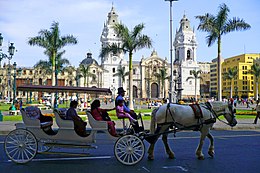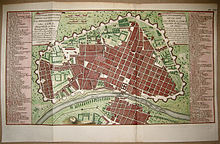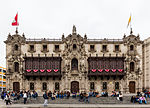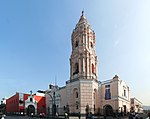Historic Centre of Lima
| UNESCO World Heritage Site | |
|---|---|
 The Cathedral of Lima located in the main square of the historic center | |
| Location | Lima, Peru |
| Criteria | Cultural: (iv) |
| Reference | 500bis |
| Inscription | 1988 (12th Session) |
| Extensions | 1991, 2023 |
| Area | 259.36 ha (640.9 acres) |
| Buffer zone | 766.7 ha (1,895 acres) |
| Coordinates | 12°3′5″S 77°2′35″W / 12.05139°S 77.04306°W |
The Historic Centre of Lima (
Founded on January 18, 1535, by Conquistador
Originally contained by the now-demolished
.History

The city of Lima, the capital of Peru, was founded by
Under the
In 1988,
On January 18, 2024, the city's 489th anniversary, president Dina Boluarte announced a "special regime" that targets the area in order to allow restoration and repair works to take place.[8]
List of sites
The World Heritage Site, divided into three zones,[2] features a number of landmarks.
Historic Centre of Lima
The main zone is that of the Historic Centre of Lima (266.17 ha; buffer zone: 806.71 ha),[2] which features the following:
| Name | Location | Notes | Photo |
|---|---|---|---|
| Balconies of Lima | Various | Over 1,600[citation needed] were built in total in both the viceregal and republican eras of the city. They have been crucial in UNESCO's declaration of the historic centre as a World Heritage Site.[2] |  |
| Archbishop's Palace | Jr. Junín & Carabaya | The home of the Archbishop of Lima, it was turned into an episcopal seat in 1541 by Pope Paul III and rebuilt in 1924 by architects Claude Sahut and Ricardo de Jaxa Malachowski as part of the city works commissioned by Augusto B. Leguía in preparation of the centennial celebrations of the Battle of Ayacucho.[9]
|
 |
| Basilica and Convent of Saint Dominic | Jr. Camaná & Conde de Superunda | The 16th century complex, originally named after Royal University of Lima was founded in 1551, and was elevated to basilica in 1930.
|
 |
| Basilica and Convent of Saint Francis | Jr. Áncash & Lampa | The 17th century complex is named after Zurbarán Room, as well as an underground network of galleries and catacombs that served as a cemetery during the Viceregal era.
|
 |
| Basilica and Convent of Saint Peter | Jr. Azángaro & Ucayali | The 17th century complex, formerly named after Ambrosio O'Higgins, as well as the site of the heart of the Viceroy Count of Lemos.[10]
|
 |
Basilica and Convent of Our Lady of Mercy
|
Jr. Unión & Sta. Rosa | The 16th century complex is named after independence of Peru in 1821.[11]
|
 |
| Casa de Aliaga | Jr. Unión 225 | The building—the oldest in the city—dates back to May 1536, belonging to Conquistador Jerónimo de Aliaga and built on top of a pre-Columbian sanctuary. It was destroyed by the earthquake of 1746 and rebuilt by Juan José Aliaga y Sotomayor. In the 19th century a series of works were carried out.[12] |  |
| Casa de Goyeneche | Jr. Ucayali 358 | The 959.20 m2 two-storey building was built during the 18th century and is named after the family that formerly owned it. After passing through a series of different owners, it was ultimately acquired by the Banco de Crédito del Perú in 1971.[13] |  |
| Casa del Oidor | Jr. Junín & Carabaya | The building was built on two of the four plots that made up one of the 117 blocks into which Lima was initially divided. Also damaged and rebuilt after the 1746 earthquake,[14] it is best known for the large balcony that runs through its façade.[15] |  |
| Casa de Pilatos | Jr. Áncash 390 | Built in the late 16th century, it was occupied by various families of the aristocracy of Lima for most of its history,[16][17] being purchased by the government during the 20th century. It currently functions as the de facto headquarters of the Constitutional Court. |  |
| Casa Riva-Agüero | Jr. Camaná 459 | This house was constructed in the 18th century by the Riva Agüero family, whose last member, the intellectual José de la Riva-Agüero, donated it to the Pontifical Catholic University of Peru. It currently serves as the headquarters of the university's Riva-Agüero Institute, where its archive and library are located. |  |
Government Palace
|
Jr. Junín | Originally built to be the residence of Oscar R. Benavides by architects Claude Sahut and Ricardo de Jaxa Malachowski, with construction works finishing in 1937. The palace currently serves as the residence of the President of the Republic .
|
 |
| Metropolitan Cathedral | Jr. Carabaya & Huallaga | Built alongside the city in 1535, its current form was built between 1602 and 1797, and is dedicated to Juan Luis Cipriani, is to celebrate mass every Sunday at 11:00 a.m. In 2005, Mayor Luis Castañeda oversaw a project of illuminating the exterior of the cathedral with new lights.
|
 |
| Museum of Congress and the Inquisition | Jr. Junín 548 | Located in the neighbourhood of Peruvian Senate until 1939. The museum dedicated to both occupants was opened on July 26, 1968.
|
 |
| Museum of Italian Art | P.° de la República 250
|
The only European arts museum of Peru, it was the gift from the Italian colony to the city as part of the centennial celebrations that took place in 1921. Designed by architect Gaetano Moretti, it was inaugurated on November 11 of the same year. |  |
| Plaza Dos de Mayo | The square was built in 1874 by the Peruvian government to commemorate the Battle of Callao, which took place off the coast of Callao on May 2, 1866, between the navies of Peru and Spain. It serves as the intersection of Colonial, Alfonso Ugarte and Colmena avenues. |  | |
Plaza Mayor
|
The site of the foundation of the city, it also served as the location of one of independence of Peru in 1821.[11]
|
 | |
| Plaza San Martín | The square was built to coincide with the centennial celebrations that took place in 1921, having replaced a train station and featuring a monument to José de San Martín, the work of Spanish sculptor Mariano Benlliure. It features buildings such as the Gran Hotel Bolívar, the National Club and the Teatro Colón. Two buildings surrounding the plaza have caught fire in recent years: the Giacoletti Building, in 2018,[18] and the Marcionelli Building, in 2023.[19][20] |  | |
| Sanctuary and Monastery of Las Nazarenas | Av. Tacna & Jr. Huancavelica | The complex was built during the 18th century after the original building had to be demolished as it was irreparably damaged during the earthquake of 1746. It is the location of the Lord of Miracles, an icon venerated by local Catholics during festivities that take place every October. |  |
| Torre Tagle Palace | Jr. Ucayali 363 | Built during the early 18th century using materials from Spain, Panama and other Central American countries,[21] it was purchased by the government in 1918 and currently serves as the main headquarters of the Ministry of Foreign Affairs. |  |
| University of San Marcos Campus and adjacent park | Av. Colmena 1222 | Formerly a Jesuit novitiate, the building and park are the property of the University of San Marcos, where its cultural centre and crypt are located. The park was built in 1870, with a clock tower being built by the German colony as part of the centennial celebrations in 1921. At noon, their bells play notes of the national anthem.
|
 |
Ancient Reduction of Santiago Apostle of Cercado
The Ancient Reduction of Santiago Apostle of Cercado (10.2 ha) was added to the World Heritage Site in 2023.[2]
| Name | Location | Notes | Photo |
|---|---|---|---|
| Bastión de Santa Lucía | Jr. José de la Rivera & Dávalos 491-499 | One of the few remains of the walls of Lima, preserved better than the other remains.[22] | — |
| Cinco esquinas (partial) | In the 19th century, it was a place where Lima's | — | |
| Santiago Apóstol del Cercado | Jr. Conchucos 720 | Rebuilt after the 1746 earthquake, the barroque church was again affected by the Virgin of Carmel was enshrined in the church during a ceremony attended by then president Augusto B. Leguía on July 16, 1921.[25]
|
 |
| Plazuela del Cercado | Originally an Indian reduction,[b] it is unique in the continent, as it has a rhomboid shape.[27] | ||
| Santo Cristo de las Maravillas | Av. Sebastián Lorente & Jr. Áncash | Named after the devotion of the same name, General Cemetery of Lima, given its location, which precedes the cemetery's foundation in 1808.[28]
|
 |
Quinta and Molino de Presa
The Quinta and Molino de Presa (1.62 ha) were added to the World Heritage Site in 2023.[2]
| Name | Location | Notes | Photo |
|---|---|---|---|
| Quinta and Molino de Presa | Jr. Chira 344[30] | The 18th century building was built under the government of then viceroy of Peru, Manuel de Amat y Junyent. It comprises a constructed area of 15,159 square metres (163,170 sq ft).[31]
|
 |
| Callejón de Presa | A passage and street that leads to the Quinta.[32] | — | |
| Plazuela de Presa | The public square outside the Quinta.[33] | — | |
See also
Notes
- ^ PROLIMA member Juan Miguel Delgado explains that, although the emblem used by the Blue Shield International (officially represented in Peru by the Comité Peruano del Escudo Azul Peruano since January 30, 2019) is a blue-and-white shield, a different colour was specifically chosen to contrast with the buildings' façades, with black serving as a neutral alternative to the stardard navy blue.[3]
- evangelisation and cultural assimilation.[26]
References
- ^ "Centro Histórico de Lima: Patrimonio Mundial". Sitios del Patrimonio Mundial del Perú.
- ^ a b c d e f g h i j "Historic Centre of Lima". World Heritage Convention. UNESCO.
- ^ Tolentino, Scheila (9 May 2023). "Centro de Lima: ¿por qué algunas edificaciones tienen un escudo blanco y negro? Esta es la razón". La República.
- ^ Martínez Hoyos, Francisco (15 March 2018). "Lima, la joya del virreinato del Perú". La Vanguardia.
- Universidad de San Martín de Porres.
- ^ Pereyra Colchado, Gladys (27 September 2020). "Los secretos de una Lima subterránea y su relación con el hallazgo en la plazuela San Francisco". El Comercio.
- ISBN 978-9972-726-13-2. Retrieved 3 November 2017.
- ^ "Presidenta Boluarte destaca ley que crea régimen especial del Centro Histórico de Lima". El Peruano. 17 January 2024.
- Universidad Ricardo Palma. 2017. pp. 7, 17.
- Medium.com. Cultura Para Lima.
- ^ a b Garay, Karina (28 July 2023). "Fiestas Patrias: estas son las 4 plazas de Lima donde se gritó la Independencia".
- ^ Salmón Salazar, Gisella (1 February 2010). "Cinco Siglos de Historia: Casa de Aliaga" (PDF). Variedades. pp. 2–4.
- ^ Planas, Enrique. "Las casonas del Centro de Lima". El Comercio.
- ^ "La casona más antigua de Lima". El Peruano. 19 November 2017.
- ^ Fangacio Arakaki, Juan Carlos (10 March 2018). "Balcones de Lima: levantar la mirada a la tradición". El Comercio.
- ^ Bromley Seminario, Juan (2019). Las viejas calles de Lima (PDF) (in Spanish). Lima: Metropolitan Municipality of Lima. p. 382.
- ^ Víctor Angles Vargas (1983). Historia del Cusco Colonial. Vol. II. Lima: Industrialgrafica .S.A. p. 742.
- ^ Ardiles, Abby (21 May 2022). "Edificio Giacoletti: ¿Cuáles son los planes de la municipalidad para poder restaurarlo?". El Comercio.
- ^ "La jornada de la "toma de Lima" termina con enfrentamientos y el incendio en un edificio en el centro histórico de la capital peruana". BBC Mundo. 20 January 2023.
- Trome.
- ^ "Historia del Palacio de Torre Tagle". Ministry of Foreign Affairs of Peru. Archived from the original on 8 September 2012.
- ^ Cubillas Soriano, Margarita (1993). Guía histórica, biográfica, e ilustrada de los monumentos de "Lima metropolitana" (in Spanish). p. 37.
- ISSN 1134-6582.
- ^ Blanco Bonilla, David (23 March 2016). "De Miraflores a Cinco esquinas, la Lima de Vargas Llosa". La Vanguardia.
- Cultura Para Lima. 2 October 2017.
- Real Academia Española. 2014.
- Cultura Para Lima. 27 August 2018.
- ^ a b "Turismo en Iglesia de Santo Cristo de Las Maravillas". Turismoi.pe.
- ^ Bromley Seminario, Juan (2019). Las viejas calles de Lima (PDF) (in Spanish). Lima: Metropolitan Municipality of Lima. pp. 60–61.
- ^ Gamarra Galindo, Marco (13 January 2010). "De visita por la Quinta de Presa". El Comercio.
- ^ "Quinta Presa". Ministerio de Comercio Exterior y Turismo del Perú.
- Blog PUCP.
- ^ Pastorelli, Giuliano (27 October 2011). "Ganadores del Concurso de Tratamiento para el Espacio Público El Rímac". ArchDaily.


